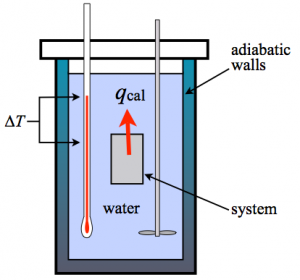Difference between revisions of "PChem312 f20 w3"
Jump to navigation
Jump to search
| Line 40: | Line 40: | ||
:::*[https://en.wikipedia.org/wiki/Table_of_specific_heat_capacities Wiki - Heat Capacities] | :::*[https://en.wikipedia.org/wiki/Table_of_specific_heat_capacities Wiki - Heat Capacities] | ||
:::*[http://www.vaxasoftware.com/doc_eduen/qui/caloresph2o.pdf table] | :::*[http://www.vaxasoftware.com/doc_eduen/qui/caloresph2o.pdf table] | ||
| − | |||
| − | |||
| − | |||
| − | |||
| − | |||
| − | |||
| − | |||
| − | |||
| − | |||
| − | |||
| − | |||
===Wednesday, Sept 2, 2020=== | ===Wednesday, Sept 2, 2020=== | ||
Revision as of 12:50, 2 September 2020
Monday, Aug 31, 2020
Continue reading chapter 2
Sec 2.1: Internal Energy and !st Law of Thermodynamics (review)
U <-- internal energy (1st thermodynamic state function)
- Uf - Ui = ΔU, the change in the internal energy
- we cannot measure Uf or Ui, only ΔU.
First Law of Thermodynamics: the change in the system's internal energy is equal to, but opposite in sign, to the change in the surround's internal energy.
- ΔUsys = - ΔUsurr
How does one measure ΔU?
- - changes in the system variables (ΔP, ΔV, ΔT, Δn) are an indication of ΔU; changes in system variables result in either heat (q) transfer or work (w) being done on or by the system; calculation of q or w leads directly to ΔU.
- ΔP, ΔV, ΔT, Δn --> q (heat), w (work) --> ΔU
- Heat and work are both defined as a transfer of energy between the system and surroundings.
The first Law of thermodynamics can also be stated as:
- ΔU = q + w
Sec 2.2: Heat (q)
- Heat is transitory; heat is not a thing. We DO NOT use the term Δq (for change in heat), we instead say that heat flows from one place to another.
- Heat naturally flows from hotter/higher temperature to cooler/lower temperature objects (Zeroth Law of Thermodynamics).
- Heat sign convention
- - we speak of heat from the perspective of the system (unless otherwise stated).
- - when the system loses heat, we identify this quantity of heat as negative (or lost), -q; loss of heat is generally associated with a decrease in temperature, ↓T.
- - when the system gains heat, we identify this quantity of heat as positive, +q or q (or gained); ; gain of heat is generally associated with a increase in temperature, ↑T.
- Example
heat (or caloric <-- historical) is measured by using a heat-meter or a calorie-meter, or calorimeter; hence calorimetry.
- measure ΔT --> ΔT ∝ q,
- q = mass of H2O * specific heat/heat capacity * ΔT
- Note: heat capacity is not really a constant...
Wednesday, Sept 2, 2020
Thursday, Sept 3, 2020
Meet in CSB 378
